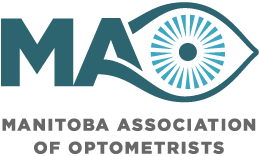It's important to ensure that a child's eyes are healthy and developing properly.
Young children may not be able to verbalize problems that they are experiencing with vision, and children may accept poor vision and other eye problems because they are unaware that their vision is not the same as that of other children. The Canadian Association of Optometrists recommends that children have their first eye exam at 6 to 9 months of age, then at approximately age 3 and again before starting school, followed by annual eye exams. Before a child begins school, it's important to assess their visual development to ensure there are no issues that will affect a child's ability to learn and succeed in school. Conditions such as crossed eyes or lazy eye can often be fully corrected if detected and treated at an early age.
Strabismus
Strabismus, commonly known as "crossed eyes," is a neuro-muscular condition in which a person cannot hold the eyes in alignment. One or both of the eyes may turn in, out, up, or down. Eye coordination begins to develop in infancy and if a child's eye muscles are not able to work together properly, strabismus may develop. Children with strabismus may initially experience double vision because both eyes are not focusing on the same object. In an attempt to avoid double vision, the brain eventually disregards the image from one eye.
Strabismus generally appears before a baby reaches 21 months old. Treatment can include eyeglasses, prisms, vision therapy, and in some cases, surgery. A child will not outgrow strabismus without treatment; in fact, the condition may worsen. However, strabismus can be corrected with excellent results if detected and treated early.
Amblyopia
Amblyopia, or lazy eye, is the loss or lack of development of vision in an eye that is otherwise healthy. Amblyopia can be caused by unequal refractive error, extreme farsightedness or nearsightedness, crossed-eyes (strabismus), or a physical visual obstruction like a cataract. The brain "learns" to see with the good eye only, and the other eye grows weaker from disuse. It is estimated that 2-4% of all children have amblyopia. Amblyopia is responsible for more cases of vision loss in children than all other ocular diseases and traumas combined. If detected and treated at an early age, amblyopia will often resolve completely.
Click here to read about How the Eye Works and common vision issues such as Hyperopia and Myopia
Click here to read about Conjunctivitis and Pink Eye
Possible Signs of Vision Problems in Children:
Be alert for symptoms that could indicate a child has a visual problem, including:
- Headaches
- Double Vision
- Red, itchy or watering eyes
- Sensitivity to light
- An eye that turns in, out, up, or down
- A drooping eyelid
- Squinting, rubbing the eyes, fatigue, or excessive blinking
- A lack of concentration
- Covering or closing one eye
- Holding objects very close to the face
- Avoiding tasks that require close work
- Avoiding books and television
- Skipping lines or losing their place while reading
- Visible frustration or grimacing
- Tilting the head or unusual posture
Pediatric Ophthalmology
In some cases, a child with a vision issue may be referred to a pediatric ophthalmologist at the Children's Hospital. Ophthalmologists are medical doctors who perform eye surgeries and provide treatment of eye diseases and disorders. They usually accept patients only on referral from an optometrist or general practitioner.
Electronic Screens & Children's Vision
The Canadian Association of Optometrists and Canadian Ophthalmological Society have issued a Joint Position Statement on electronic screens and children's vision. Read the Statement here:
Effects of Electronic Screens on Children's Vision and Recommendations for Safe Use (pdf)
To read more about children's eye health and vision, visit these pages:
